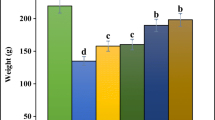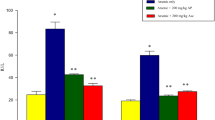Abstract
In recent years, Iranian traditional medicine has been used to treat various diseases such as anemia. One of these plants is Ocimum basilicum L. In this experiment, we evaluated the anti-anemia and antioxidant properties of aqueous extract of O. basilicum in phenylhydrazine-induced anemic rats. 2,2-Diphenyl-1-picrylhydrazyl (DPPH) free radical scavenging test was used to examine the antioxidant property of O. basilicum aqueous extract, which indicated high antioxidant property compared to butylated hydroxytoluene (BHT) as the positive control. In vivo design, after 1 day of the last injection of phenylhydrazine, the rats were divided into five subgroups, including negative healthy control, untreated negative control, and three groups receiving the O. basilicum at 20, 60, and 180 mg/kg concentrations. At the end of day 15 of treatment, the animals of all groups were euthanized and blood samples were drawn immediately from the animals’ hearts to analyze the hematological and biochemical parameters. The data were analyzed by SPSS-21 software. Several doses of O. basilicum (especially O180) significantly (p ≤ 0.05) enhanced the levels of body weight, WBC, neutrophils, monocytes, platelet, RBC, Hb, PCV, MCV, MCH, MCHC, and reduced the raised levels of ALP, AST, ALT, GGT, urea, creatinine, ferrous, ferritin, and erythropoietin as compared to the untreated group. In conclusion, the obtained results revealed the anti-anemia and antioxidant properties of aqueous extract of O. basilicum. Extraction of active molecules will be the future work to peruse.















Similar content being viewed by others
References
Beaven GH, White JC (1954) Oxidation of phenylhydrazines in the presence of oxyhaemoglobin and the origin of Heinz bodies in erythrocytes. Nature 27:389–391
Bjelakovic G, Nikolova D, Simonetti RG, Gluud C (2004) Antioxidant supplements for prevention of gastrointestinal cancers: a systematic review and meta-analysis. Lancet 364:1219–1228
Boretti FS, Buehler PW, D’Agnillo F, Kluge K, Glaus T, Butt OI, Jia Y, Goede J, Pereira CP, Maggiorini M, Schoedon G, Alayash AI, Schaer DJ (2009) Sequestration of extracellular hemoglobin within a haptoglobin complex decreases its hypertensive and oxidative effects in dogs and guinea pigs. J Clin Invest 119(8):2271–2280
Bratosin D, Mazurier J, Tissier JP, Estaquier J, Huart JJ, Ameisen JC, Aminoff D, Montreuil J (1998) Cellular and molecular mechanisms of senescent erythrocyte phagocytosis by macrophages. A review. Biochimie 80(2):173–195
Cheraghi M, Asadi-Samani M (2016) Hematopoietic medicinal plants based on ethnobotanical documents of Iran: a strategy to develop nature-based drugs effective on anemia. Pharm Lett 8(5):393–399
Farzaei MH, Zangeneh MM, Goodarzi N, Zangeneh A (2018) Stereological assessment of nephroprotective effects of Trachyspermum ammi essential oil against carbon tetrachloride-induced nephrotoxicity in mice. Int J Morphol 36(2):750–757
Ferrali M, Signorini C, Sugherini L, Pompella A, Maura L, Caciotti B, Ciccoli L, Comporti M (1997) Release of free redoxactive iron in the liver and DNA oxidative damage following phenylhydarzine intoxication. Biochem Pharmacol 53(11):1743–1751
Giffin H, Allen E (1993) The control and complete remission of polycythemia vera following the prolonged administration of phenylhydrazine hydrochloride. Am J Med Sci 185:1–13
Goldberg B, Stern A (1975) The generation of O2-by the interaction of the hemolytic agent, phenylhydrazine, with human hemoglobin. J Biol Chem 25(6):2401–2403
Hamelian M, Zangeneh MM, Amisama A, Varmira K, Veisi H (2018) Green synthesis of silver nanoparticles using Thymus kotschyanus extract and evaluation of their antioxidant, antibacterial and cytotoxic effects. Appl Organomet Chem. https://doi.org/10.1002/aoc.4458
Holley RA, Patel D (2005) Improvement in shelf life and safety of perishable foods by plant essential oils and smoke antimicrobials. J Food Microbiol 22(4):273–292
Horn S, Gopas J, Bashan N (1990) A lectin like receptor on murine macrophage is involved in the recognition and phagocytosis of human red cells oxidized by phenylhydrazine. Biochem Pharmacol 39(4):775–780
Hosseinimehr SJ, Mahmoudzadeh A, Ahmadi A, Ashrafi SA, Shafaghati N, Hedayati N (2011) The radioprotective effect of Zataria multiflora against genotoxicity induced by γ irradiation in human blood lymphocytes. Cancer Biother Radiopharm 26(3):325–329
Khair-ul-Bariyah S, Ahmed ID, Ikram M (2012) Ocimum basilicum: a review on phytochemical and pharmacological studies. Pak J Chem 2(2):78–85
Kim J, Marshal M, Wei C (1995) Antibacterial activity of some essential oil components against five food borne pathogens. J Agric Food Chem 43(11):2839–2845
Lee HW, Kim H, Ryuk JA, Kil KJ, Ko BS (2014) Hemopoietic effect of extracts from constituent herbal medicines of Samul-tang on phenylhydrazine-induced hemolytic anemia in rats. Int J Clin Exp Pathol 7(9):6179–6185
Lippi G, Schena F, Salvagno GL, Aloe R, Banfi G, Guidi GC (2012) Foot-strike haemolysis after a 60-km ultramarathon. Blood Transfus 10(3):377–383
Mansuy D, Battioni P, Mahy JP, Gillet G (1982) Comparison of the hemoglobin reactions with methyl-and phenyl-hydrazine; intermediate formation of a hemoglobin Fe-(II)-methyldiazene complex. Biochem Biophys Res Commun 106(1):30–36
Meera R, Devi P, Kameswari B, Mahumita B, Merlin JN (2009) Antioxidant and hepatoprotective activities of Ocimum basilicum Linn. and Trigonella foenum-graecum Linn. against H2O2 and CCl4 induced hepatoyoxicity in goat liver. Indian J Exp Biol 47(7):584–590
Moradi R, Hajialiani M, Salmani S, Almasi M, Zangeneh A, Zangeneh MM (2018) Effect of aqueous extract of Allium saralicum R.M. Fritsch on fatty liver induced by high-fat diet in Wistar rats. Comp Clin Pathol. https://doi.org/10.1007/s00580-018-2834-y
Omenn GS, Goodman GE, Thornquist MD, Balmes J, Cullen MR, Glass A, Keogh JP, Meyskens FL, Valanis B, Williams JH, Barnhart S, Hammar S (1996) Effects of a combination of beta carotine and vitamin A on lung cancer and cardiovascular disease. N Engl J Med 334(18):1150–1155
Pham-Quang-Chi (1979) Toxicity of inhaled phenylhydrazine (Russian). Gig Tr Prof Zabol 3:45–47
Qaseem A, Humphrey LL, Fitterman N, Starkey M, Shekelle P (2013) Clinical Guidelines Committee of the American College of, Physicians. Treatment of anemia in patients with heart disease: a clinical practice guideline from the American College of Physicians. Ann Intern Med 159(11):770–779
Rashidi K, Mahmoudi M, Mohammadi G, Zangeneh MM, Korani S, Goicoechea HC, Gu H, Jalalvand AR (2018) Simultaneous co-immobilization of three enzymes onto a modified glassy carbon electrode to fabricate a high-performance amperometric biosensor for determination of total cholesterol. Int J Biol Macromol 120:587–595
Rifkind RA (1965) Heinz body anaemia-an ultrastructural study II red cell sequestration and destruction. Blood 26(4):433–448
Rifkind RA, Danon D (1965) Heinz body anaemia–an ultrastructural study I Heinz body formation. Blood 25(6):885–895
Saha S, Mukhopadhyay MK, Ghosh PD, Nath D (2012) Effect of methanolic leaf extract of Ocimum basilicum L. on benzene-induced hematotoxicity in mice. Evid Based Complement Alternat Med. https://doi.org/10.1155/2012/176385
Sayyedrostami T, Pournaghi P, Ebrahimi Vosta-Kalaeea S, Zangeneh MM (2018) Evaluation of the wound healing activity of Chenopodium botrys leaves essential oil in rats (a short-term study). J Essent Oil Bear Pl 21(1):164–174
Sherkatolabbasieh H, Hagh-Nazari L, Shafiezadeh S, Goodarzi N, Zangeneh MM, Zangeneh A (2017) Ameliorative effects of the ethanolic extract of Allium saralicum R.M. Fritsch on CCl4-induced nephrotoxicity in mice: a stereological examination. Arch Biol Sci 69(3):535–543
Telford RD, Sly GJ, Hahn AG, Cunningham RB, Bryant C, Smith JA (2003) Footstrike is the major cause of hemolysis during running. J Appl Physiol 94(1):38–42
Witchett CE (1975) Exposure of dog erythrocytes in vivo to phenylhydrazine and monomethylhydrazine. A freeze-etch study of erythrocyte damage. Aerospace Medical Research Laboratory, Aeorospace Medical Division, AFSC, Wright-Patterson Air Force Base, Report No: AMRL-TR-74-88. NTIS Publication No AD-A011 555
Zangeneh MM, Salmani S, Zangeneh A, Bahrami E, Almasi M (2018a) Antiulcer activity of aqueous extract of leaves of Mentha piperita in Wistar rats. Comp Clin Pathol. https://doi.org/10.1007/s00580-018-2827-x
Zangeneh MM, Salmani S, Zangeneh A, Khedri R, Zarei MS (2018b) Histopathological and biochemical effects of aqueous extract of Tragopogon graminifolius on the liver tissues of Wistar rats fed with high-fat diet. Comp Clin Pathol. https://doi.org/10.1007/s00580-018-2828-9
Zaveri M, Desai N, Movaliya V (2012) Effect of Ocimum basilicum on cisplatin models of acute renal failure. ARPB 1(2):91–100
Zhaleh M, Sohrabi N, Zangeneh MM, Zangeneh A, Moradi R, Zhaleh H (2018) Chemical composition and antibacterial effects of essential oil of Rhus coriaria fruits in the west of Iran (Kermanshah). J Essent Oil Bear Pl 21(2):493–501
Funding
The authors would like to thank the Kermanshah University of Medical Sciences for the financial support.
Author information
Authors and Affiliations
Corresponding author
Ethics declarations
Conflict of interest
The authors declare that they have no conflict of interest.
Ethical approval
All institutional and national guidelines for the care and use of laboratory animals were followed.
Rights and permissions
About this article
Cite this article
Zangeneh, M.M., Zangeneh, A., Salmani, S. et al. Protection of phenylhydrazine-induced hematotoxicity by aqueous extract of Ocimum basilicum in Wistar male rats. Comp Clin Pathol 28, 331–338 (2019). https://doi.org/10.1007/s00580-018-2845-8
Received:
Accepted:
Published:
Issue Date:
DOI: https://doi.org/10.1007/s00580-018-2845-8




